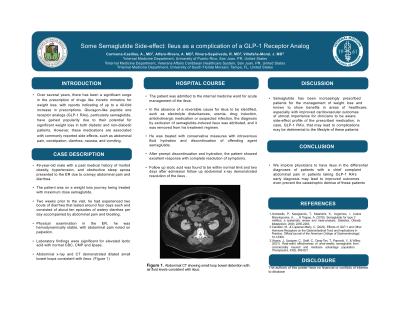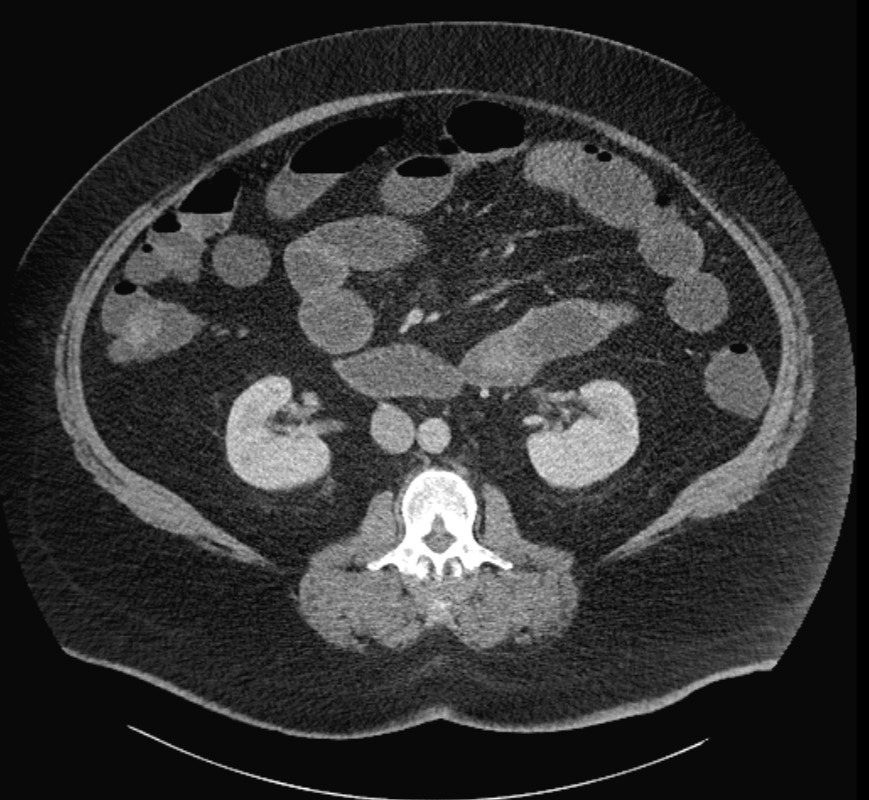Monday Poster Session
Category: Obesity
P3178 - Some Semaglutide Side Effect: Ileus as a Complication of a GLP-1 Receptor Analog
Monday, October 28, 2024
10:30 AM - 4:00 PM ET
Location: Exhibit Hall E

Has Audio
- AC
Alejandro Carmona Casillas, MD
University of Puerto Rico School of Medicine
San Juan, PR
Presenting Author(s)
Alejandro Carmona Casillas, MD1, Alexander Rivera Alfaro, MD2, Rafael Rivera Sepulveda, MD3, Jesus Villafane Moral, MD2
1University of Puerto Rico School of Medicine, San Juan, Puerto Rico; 2VA Caribbean Healthcare System, San Juan, Puerto Rico; 3University of South Florida Morsani College of Medicine, Tampa, FL
Introduction: For the past several years drugs such as incretin mimetics have been widely prescribed for weight loss with reports of up to a 40-fold increase in prescriptions. The popularity of glucagon-like peptide 1 receptor analogs (GLP-1 RAs) has undoubtedly increased its potential for significant weight loss in diabetic and non-diabetic patients. These medications, including semaglutide, have a wide variety of commonly reported side effects such as abdominal pain, constipation, diarrhea, nausea, and vomiting.
Case Description/Methods: This is the case of a 49-year-old male with a past medical history of morbid obesity who presented to the emergency room (ER) due to crampy abdominal pain and diarrhea of 2 weeks onset. The patient was being treated for obesity with a maximum dose of semaglutide weekly. His dose had been increased as tolerated over the past four months. 2 weeks before his visit to the ER, he had experienced 2 bouts of diarrhea that lasted four days each. These bouts consisted of 10 episodes of watery diarrhea per day accompanied by abdominal pain and bloating. In the ER, he was afebrile and hemodynamically stable. Physical exam was remarkable for a diffusely tender abdomen to palpation. Laboratory findings showed elevated lactic acid and no anomalies in his CBC or CMP. Abdominal CT demonstrated dilated small bowel loops consistent with ileus. A drug toxicology was negative. Given no electrolyte disturbances, uremia, recent drug induction, recent anticholinergic medication or infection, semaglutide-induced ileus was attributed and it was removed from his treatment regimen. The patient demonstrated excellent response to intravenous fluid hydration with complete resolution of his lactatemia. Follow-up abdominal x-ray 2 days after admission showed a normal gas bowel pattern resulting in complete resolution of the ileus and he was discharged with recommendation to avoid semaglutide.
Discussion: Semaglutide has been increasingly prescribed to patients for weight loss management and is known to show benefits outside of weight loss such as improved cardiovascular outcomes. It is important for clinicians to be aware of the side-effect profile of GLP-1 RAs that may lead to complications that may be detrimental to patients. We implore physicians to have ileus in the differential diagnoses of patients with a chief complaint of abdominal pain in patients taking GLP-1 RAs since early diagnosis may lead to improved outcomes and even prevent the catastrophic demise of these patient populations.

Disclosures:
Alejandro Carmona Casillas, MD1, Alexander Rivera Alfaro, MD2, Rafael Rivera Sepulveda, MD3, Jesus Villafane Moral, MD2. P3178 - Some Semaglutide Side Effect: Ileus as a Complication of a GLP-1 Receptor Analog, ACG 2024 Annual Scientific Meeting Abstracts. Philadelphia, PA: American College of Gastroenterology.
1University of Puerto Rico School of Medicine, San Juan, Puerto Rico; 2VA Caribbean Healthcare System, San Juan, Puerto Rico; 3University of South Florida Morsani College of Medicine, Tampa, FL
Introduction: For the past several years drugs such as incretin mimetics have been widely prescribed for weight loss with reports of up to a 40-fold increase in prescriptions. The popularity of glucagon-like peptide 1 receptor analogs (GLP-1 RAs) has undoubtedly increased its potential for significant weight loss in diabetic and non-diabetic patients. These medications, including semaglutide, have a wide variety of commonly reported side effects such as abdominal pain, constipation, diarrhea, nausea, and vomiting.
Case Description/Methods: This is the case of a 49-year-old male with a past medical history of morbid obesity who presented to the emergency room (ER) due to crampy abdominal pain and diarrhea of 2 weeks onset. The patient was being treated for obesity with a maximum dose of semaglutide weekly. His dose had been increased as tolerated over the past four months. 2 weeks before his visit to the ER, he had experienced 2 bouts of diarrhea that lasted four days each. These bouts consisted of 10 episodes of watery diarrhea per day accompanied by abdominal pain and bloating. In the ER, he was afebrile and hemodynamically stable. Physical exam was remarkable for a diffusely tender abdomen to palpation. Laboratory findings showed elevated lactic acid and no anomalies in his CBC or CMP. Abdominal CT demonstrated dilated small bowel loops consistent with ileus. A drug toxicology was negative. Given no electrolyte disturbances, uremia, recent drug induction, recent anticholinergic medication or infection, semaglutide-induced ileus was attributed and it was removed from his treatment regimen. The patient demonstrated excellent response to intravenous fluid hydration with complete resolution of his lactatemia. Follow-up abdominal x-ray 2 days after admission showed a normal gas bowel pattern resulting in complete resolution of the ileus and he was discharged with recommendation to avoid semaglutide.
Discussion: Semaglutide has been increasingly prescribed to patients for weight loss management and is known to show benefits outside of weight loss such as improved cardiovascular outcomes. It is important for clinicians to be aware of the side-effect profile of GLP-1 RAs that may lead to complications that may be detrimental to patients. We implore physicians to have ileus in the differential diagnoses of patients with a chief complaint of abdominal pain in patients taking GLP-1 RAs since early diagnosis may lead to improved outcomes and even prevent the catastrophic demise of these patient populations.

Figure: Abdominal CT showing small loop bowel distention with air fluid levels consistent with ileus
Disclosures:
Alejandro Carmona Casillas indicated no relevant financial relationships.
Alexander Rivera Alfaro indicated no relevant financial relationships.
Rafael Rivera Sepulveda indicated no relevant financial relationships.
Jesus Villafane Moral indicated no relevant financial relationships.
Alejandro Carmona Casillas, MD1, Alexander Rivera Alfaro, MD2, Rafael Rivera Sepulveda, MD3, Jesus Villafane Moral, MD2. P3178 - Some Semaglutide Side Effect: Ileus as a Complication of a GLP-1 Receptor Analog, ACG 2024 Annual Scientific Meeting Abstracts. Philadelphia, PA: American College of Gastroenterology.
